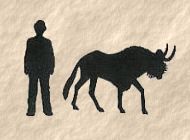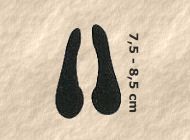 |
  |

Size

Footprint
|
Close this window to go
back to the previous page |
|
Description
|
Huge animal with long thick legs and very
large ears. Its trunk is versatile acting as a nose and hand. Usually has
long tusks. Female has one pair of mammae between the front legs. |
|
Sexual dimorphism |
Bull is larger than the cow and has larger and
heavier tusks. |
|
Habitat |
Found in areas ranging from arid to dense
forest and savanna or forest recording a high rainfall. Clear drinking
water, other permanent water, shade and enough food (grass and branches) are
essential. |
|
Habits |
Diurnal and nocturnal. Gregarious, herds
consist mainly of a cow and her descendants. Bulls form temporary male herds
or live alone, especially the old ones, only joining the cows for mating.
Large breeding herds with bulls also exist. It shows aggression when it
lifts its trunk and head, spreads out its ears and trumpets, or kicks up
dust. When drinking water it squirts it over itself or lies down to cool
off. Enjoys wallowing in mud and rubbing against trees. |
|
Voice |
Screams and trumpets. Keeps contact by deep
rumbling. |
|
Breeding |
One, rarely two, calves born at any time
during the year after a gestation period of ± 22 months. |
|
Food |
Branches, grass, leaves, bark reed and fruit.
May drink water once in four days or even daily. Water for drinking must be
clear, may even dig in the sand for water. |
|
Mass |
♂ 5700 kg
♀ 5500 kg
|
|
Life expectancy |
± 65 years |
|
Weight of tusks |
Average ± 35 kg
Record 102,72 kg
|
|
Enemies |
None |
|
Also known as |
Olifant (Afrikaans)
Loxodonta africana |
|
This
site is best viewed at 1024 X 768
Please report any problems to the Webmaster
Copyright © CoZania October 2004 |

![]()


